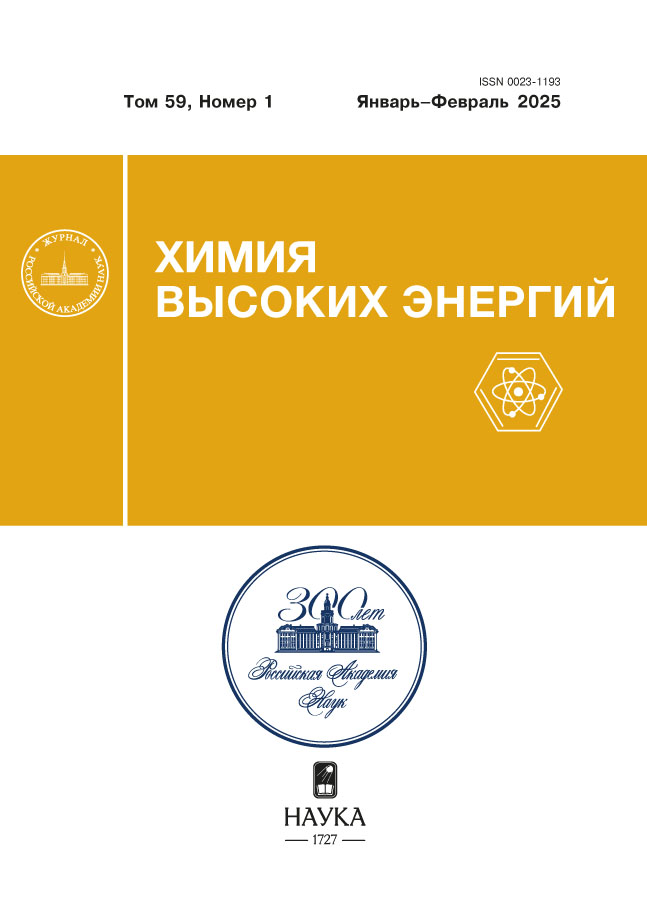Quenching of gadolinium(III) ion photoluminescence in liquid ammonia by solvated electron
- Autores: Abdrakhmanov A.M.1, Sharipov G.L.1, Gareev B.M.1, Yakshembetova L.R.1
-
Afiliações:
- Institute of Petroleum Chemistry and Catalysis, Ufa Federal Research Center, Russian Academy of Sciences
- Edição: Volume 59, Nº 1 (2025)
- Páginas: 12-17
- Seção: PHOTONICS
- URL: https://cardiosomatics.ru/0023-1193/article/view/684664
- DOI: https://doi.org/10.31857/S0023119325010023
- EDN: https://elibrary.ru/SQHKIE
- ID: 684664
Citar
Texto integral
Resumo
The effect of a solvated electron on the gadolinium(III) chloride photoluminescence in liquid ammonia at 293 K and a pressure of 8.8 atm is considered. The solubility of GdCl3 crystalline hydrate in ammonia is 5 × 10–4 M. The solvated Gd3+ ion luminescence spectrum thein this solution coincides with the hydrated Gd3+ ion luminescence spectrum in a similar aqueous solution at atmospheric pressure. The lifetime τ in the excited state (6P7/2) of the gadolinium(III) ion is longer in ammonia (2.6 ms) than in water (2.0 ms). Luminescence of (Gd3+)* in ammonia is quenched by a solvated electron (es–) formed during the dissolution of lithium metal. Under these conditions, the Gd3+ and es– solution is unstable, precipitates are formed, and there is a continuous change in the concentrations of the components involved in the quenching reaction (Gd3+)* + es– → Gd2+. Because of this, the gadolinium ion photoluminescence intensity this not applicable to assessing the quenching efficiency by a solvated electron. The quenching efficiency (τ0–τ)/τ linear dependence the on the quencher concentration was obtained by measuring the gadolinium ion τ at a variable concentration es–, which was determined from the solution optical density at 1400 nm in its absorption band. The bimolecular rate constant for the proposed quenching reaction, found from this dependence, was k = (5.3 ± 0.3) × 107 M−1 ∙ s−1.
Palavras-chave
Texto integral
Sobre autores
A. Abdrakhmanov
Institute of Petroleum Chemistry and Catalysis, Ufa Federal Research Center, Russian Academy of Sciences
Autor responsável pela correspondência
Email: abdr-73@ya.ru
Rússia, Ufa
G. Sharipov
Institute of Petroleum Chemistry and Catalysis, Ufa Federal Research Center, Russian Academy of Sciences
Email: abdr-73@ya.ru
Rússia, Ufa
B. Gareev
Institute of Petroleum Chemistry and Catalysis, Ufa Federal Research Center, Russian Academy of Sciences
Email: abdr-73@ya.ru
Rússia, Ufa
L. Yakshembetova
Institute of Petroleum Chemistry and Catalysis, Ufa Federal Research Center, Russian Academy of Sciences
Email: abdr-73@ya.ru
Rússia, Ufa
Bibliografia
- Пикаев А.К., Шилов В.П., Спицын В.И. Радиолиз водных растворов лантанидов и актинидов. М.: Наука, 1983. 240 с.
- Шарипов Г.Л., Казаков В.П. // Изв. АН СССР. Сер. хим. 1979. № 1. C. 254. https://doi.org/10.1007/BF00925442
- Казаков В.П., Шарипов Г.Л. Радиолюминесценция водных растворов. М.: Наука, 1986. 136 с.
- Kilin S.F., Rozman I.M. // Opt. Spektrosk. 1963. V. 15. № 4. P. 494.
- Stein G., Tomkiewicz M. // Trans. Faraday Soc. 1971. V. 67. № 582. P. 1678. https://doi.org/10.1039/TF9716701678
- Sharipov G.L., Abdrakhmanov A.M., Gareev B.M., Yakshembetova L.R. // High Energy Chemistry. 2024. V. 58. № 2. P. 260–264. https://doi.org/10.1134/S0018143924020103
- Sharipov G.L., Gareev B.M., Abdrakhmanov A.M. // Journal of Photochemistry and Photobiology A: Chemistry. 2020. V. 402. P. 112800. https://doi.org/10.1016/j.jphotochem.2020.112800
- Шарипов Г.Л., Гареев Б.М., Абдрахманов А.М., Якшембетова Л.Р. // Известия УНЦ РАН. 2021. № 4. С. 23. https://doi.org/10.31040/2222-8349-2021-0-4-22-29
- Abdrakhmanov A.M., Sharipov G.L., Gareev B.M., Yakshembetova L.R. // Journal of Luminescence. 2024. V. 273. 120694. https://doi.org/10.1016/j.jlumin.2024.120694
- Thompson J.C. Electrons in Liquid Ammonia. Oxford: Claredon, 1976, 297 p.
- The Engineering ToolBox (2003). Ammonia – Vapour Pressure at Gas-Liquid Equilibrium. [online] Available at: https://www.engineeringtoolbox.com/ammonia-pressure-temperature-d_361.html [Accessed 10.07.2024].
- Farhataziz, Perkey L.M., Hentz R.R. // J. Chem. Phys. 1974. V. 60. P. 4383. https://doi.org/10.1063/1.1680915
- Хайкин Г.И., Жигунов В.А., Шорников В.В. // Химия высоких энергий. 1979. Т. 13. № 4. С. 314.
- Кондратьева Е.В. // Опт. и спектр. 1958. Т. 5. C. 214.
- Кондратьева Е.В., Лазеева Г.С. // Опт. и спектр. 1960. Т. 8. C. 132.
- Telser Th., Schindewolf U. // Ber. Bunsenges. Phys. Chem. 1984. V. 88. P. 488. https://doi.org/10.1002/bbpc.19840880514
- Burow D.F., Lagowski J.J. Spectroscopy of Dilute Metal-Deuteroammonia Solutions // In Solvated Electron; Hart, E.; Advances in Chemistry; ACS: DC, 1965. P. 125−137. https://doi.org/10.1021/ba-1965-0050.ch010
- Warshawsky I. // J. Inorg. NucI. Chem. 1963. V. 25. № 5. P. 601. https://doi.org/10.1016/0022-1902(63)80247-X
- Lakowicz J.R. Principles of Fluorescence Spectroscopy. Springer Science & Business Media: Science, 2007, 954 p.
- Kavarnos G.J., Turro N.J. // Chem. Rev. 1986. V. 86. P. 401. https://doi.org/10.1021/CR00072A005
- Полуэктов Н.С., Кононенко Л.И., Ефрюшина Н.П., Бельтюкова С.В. Спектрофотометрические и люминесцентные методы определения лантанидов. Киев: Наукова Думка, 1989. 256 с.
- Piechota E.J., Meyer G.J. // J. Chem. Educ. 2019. V. 96. № 11. P. 2450. https://doi.org/10.1021/acs.jchemed.9b00489
Arquivos suplementares













